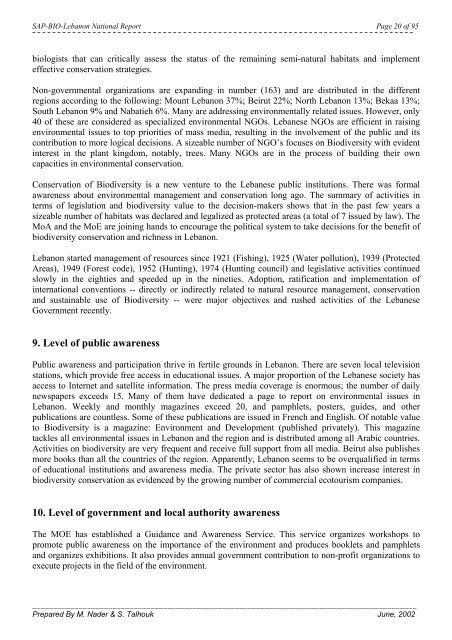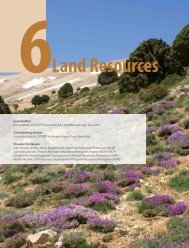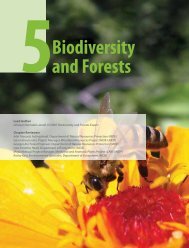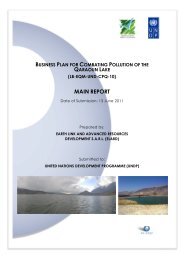Project for the preparation of a Strategic Action Plan for the ...
Project for the preparation of a Strategic Action Plan for the ...
Project for the preparation of a Strategic Action Plan for the ...
You also want an ePaper? Increase the reach of your titles
YUMPU automatically turns print PDFs into web optimized ePapers that Google loves.
SAP-BIO-Lebanon National Report Page 20 <strong>of</strong> 95<br />
¯¯¯¯¯¯¯¯¯¯¯¯¯¯¯¯¯¯¯¯¯¯¯¯¯¯¯¯¯¯¯¯¯¯¯¯¯¯¯¯¯¯¯¯¯¯¯¯¯¯¯¯¯¯¯¯¯¯¯¯¯¯¯¯¯¯¯¯¯¯¯¯¯¯¯¯<br />
biologists that can critically assess <strong>the</strong> status <strong>of</strong> <strong>the</strong> remaining semi-natural habitats and implement<br />
effective conservation strategies.<br />
Non-governmental organizations are expanding in number (163) and are distributed in <strong>the</strong> different<br />
regions according to <strong>the</strong> following: Mount Lebanon 37%; Beirut 22%; North Lebanon 13%; Bekaa 13%;<br />
South Lebanon 9% and Nabatieh 6%. Many are addressing environmentally related issues. However, only<br />
40 <strong>of</strong> <strong>the</strong>se are considered as specialized environmental NGOs. Lebanese NGOs are efficient in raising<br />
environmental issues to top priorities <strong>of</strong> mass media, resulting in <strong>the</strong> involvement <strong>of</strong> <strong>the</strong> public and its<br />
contribution to more logical decisions. A sizeable number <strong>of</strong> NGO’s focuses on Biodiversity with evident<br />
interest in <strong>the</strong> plant kingdom, notably, trees. Many NGOs are in <strong>the</strong> process <strong>of</strong> building <strong>the</strong>ir own<br />
capacities in environmental conservation.<br />
Conservation <strong>of</strong> Biodiversity is a new venture to <strong>the</strong> Lebanese public institutions. There was <strong>for</strong>mal<br />
awareness about environmental management and conservation long ago. The summary <strong>of</strong> activities in<br />
terms <strong>of</strong> legislation and biodiversity value to <strong>the</strong> decision-makers shows that in <strong>the</strong> past few years a<br />
sizeable number <strong>of</strong> habitats was declared and legalized as protected areas (a total <strong>of</strong> 7 issued by law). The<br />
MoA and <strong>the</strong> MoE are joining hands to encourage <strong>the</strong> political system to take decisions <strong>for</strong> <strong>the</strong> benefit <strong>of</strong><br />
biodiversity conservation and richness in Lebanon.<br />
Lebanon started management <strong>of</strong> resources since 1921 (Fishing), 1925 (Water pollution), 1939 (Protected<br />
Areas), 1949 (Forest code), 1952 (Hunting), 1974 (Hunting council) and legislative activities continued<br />
slowly in <strong>the</strong> eighties and speeded up in <strong>the</strong> nineties. Adoption, ratification and implementation <strong>of</strong><br />
international conventions -- directly or indirectly related to natural resource management, conservation<br />
and sustainable use <strong>of</strong> Biodiversity -- were major objectives and rushed activities <strong>of</strong> <strong>the</strong> Lebanese<br />
Government recently.<br />
9. Level <strong>of</strong> public awareness<br />
Public awareness and participation thrive in fertile grounds in Lebanon. There are seven local television<br />
stations, which provide free access in educational issues. A major proportion <strong>of</strong> <strong>the</strong> Lebanese society has<br />
access to Internet and satellite in<strong>for</strong>mation. The press media coverage is enormous; <strong>the</strong> number <strong>of</strong> daily<br />
newspapers exceeds 15. Many <strong>of</strong> <strong>the</strong>m have dedicated a page to report on environmental issues in<br />
Lebanon. Weekly and monthly magazines exceed 20, and pamphlets, posters, guides, and o<strong>the</strong>r<br />
publications are countless. Some <strong>of</strong> <strong>the</strong>se publications are issued in French and English. Of notable value<br />
to Biodiversity is a magazine: Environment and Development (published privately). This magazine<br />
tackles all environmental issues in Lebanon and <strong>the</strong> region and is distributed among all Arabic countries.<br />
Activities on biodiversity are very frequent and receive full support from all media. Beirut also publishes<br />
more books than all <strong>the</strong> countries <strong>of</strong> <strong>the</strong> region. Apparently, Lebanon seems to be overqualified in terms<br />
<strong>of</strong> educational institutions and awareness media. The private sector has also shown increase interest in<br />
biodiversity conservation as evidenced by <strong>the</strong> growing number <strong>of</strong> commercial ecotourism companies.<br />
10. Level <strong>of</strong> government and local authority awareness<br />
The MOE has established a Guidance and Awareness Service. This service organizes workshops to<br />
promote public awareness on <strong>the</strong> importance <strong>of</strong> <strong>the</strong> environment and produces booklets and pamphlets<br />
and organizes exhibitions. It also provides annual government contribution to non-pr<strong>of</strong>it organizations to<br />
execute projects in <strong>the</strong> field <strong>of</strong> <strong>the</strong> environment.<br />
___________________________________________________________________________________________<br />
Prepared By M. Nader & S. Talhouk June, 2002





